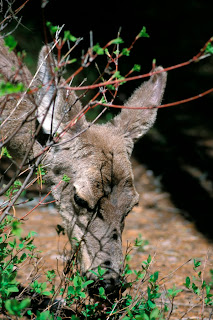 As time goes on, country sides are becoming less apparent. Human life is taking over wild animal's territory. Deer are know to eat really anything put in front of them. It is an increasing problem that deer get into person gardens and landscape to eat plants. This is very well caused because of the new suburbs created where their homes used to be.
As time goes on, country sides are becoming less apparent. Human life is taking over wild animal's territory. Deer are know to eat really anything put in front of them. It is an increasing problem that deer get into person gardens and landscape to eat plants. This is very well caused because of the new suburbs created where their homes used to be.
Tuesday, October 12, 2010
Plant/Animal Interaction
 As time goes on, country sides are becoming less apparent. Human life is taking over wild animal's territory. Deer are know to eat really anything put in front of them. It is an increasing problem that deer get into person gardens and landscape to eat plants. This is very well caused because of the new suburbs created where their homes used to be.
As time goes on, country sides are becoming less apparent. Human life is taking over wild animal's territory. Deer are know to eat really anything put in front of them. It is an increasing problem that deer get into person gardens and landscape to eat plants. This is very well caused because of the new suburbs created where their homes used to be.
Plant/Human interaction
 Plants and animals have a very important partnership. As discovered by Joseph Priestly, plants give off something that humans need to survive. We, has humans need oxygen to live. Plants need CO2 to survive. We work together because we each give off the opposite of what we need while taking in the other.
Plants and animals have a very important partnership. As discovered by Joseph Priestly, plants give off something that humans need to survive. We, has humans need oxygen to live. Plants need CO2 to survive. We work together because we each give off the opposite of what we need while taking in the other.
Economic (Wheat)
 Wheat is a member of the grass family and provides more nourishment for more people worldwide than any other food. More foods are made from wheat than any other grain. 4 years ago, in the United states alone, 57 million tonnes of wheat were produced! This makes for many jobs and products, which is a huge help to our economy.
Wheat is a member of the grass family and provides more nourishment for more people worldwide than any other food. More foods are made from wheat than any other grain. 4 years ago, in the United states alone, 57 million tonnes of wheat were produced! This makes for many jobs and products, which is a huge help to our economy. Economic (Cotton)
Sunday, October 10, 2010
Economic (Cocoa)
Cocoa is a crop grown largely by smallholder farmers in the lowland tropics, including parts of Latin America, West Africa, and Indonesia. Worldwide, there are approximately 5-6 million cocoa farmers. Every year 3 million tons of it are produced. For the past 100 years, the demand for cocoa has steadily increased by 3% each year. This industry's current global market value of annual cocoa crop is $5.1 billion. In conclusion, the production of cocoa allows many jobs, products, and is a large income for the world.
Products from Cocoa:
-Cereals
-Chocolate
-Lotions and cosmetic items
-Liquor
-Powder
Products from Cocoa:
-Cereals
-Chocolate
-Lotions and cosmetic items
-Liquor
-Powder
Thursday, October 7, 2010
Plant/Insect interaction
The pictures above represent a plant and insect interacting. Both bees and flowers benefit from this process. Just as bees depend on nectar and pollen for their continued existence, gardens depend on bees for their own survival. When bees fly from flower to flower, the pollen clings to them and is distributed to other flowers, thus encouraging flower growth.
Subscribe to:
Comments (Atom)











